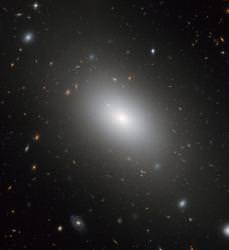As galaxies come together through successive mergers they take on the splendid spiral shape like our own Milky Way. Keep merging those larger galaxies, though, and you’ll eventually get an elliptical galaxy – a gigantic diffuse cloud of ancient stars with little structure. Such a galaxy, NGC 1132, was recently photographed by the Hubble Space Telescope.
The elliptical galaxy NGC 1132 belongs in this class of galaxies called “giant ellipticals”. And the galaxy, with its constellation of dwarf galaxies is known as a “fossil group”. They’re the remnants and wreckage from past collisions between large galaxies.
In visible light, NGC 1132 looks like a single, isolated galaxy. But using a technique called gravitational lensing to map out the surrounding dark matter, astronomers found that it resides in a huge cloud of the stuff. In fact, NGC 1132 has as much dark matter as you might find in a group of tens or even hundreds of galaxies.
And once again, in visible light, its stars extend 120,000 light years from its centre. But in the X-ray spectrum, the glow extends 10 times as far – again, similar to a group of galaxies.
So where do fossil groups like this come from? Astronomers think they’re the end product of cosmic collisions, where a single large galaxy consumes all of its neighbors. It’s also possible they’re the result of a strange process, where something stopped moderate galaxies from forming, and only a single large galaxy came together in that region of space.
By analyzing galaxies like this, astronomers will get a better sense of galaxy evolution. It’ll help predict what’s going to happen when the Milky Way and Andromeda collide billions of years in the future.
Original Source: ESA/Hubble News Release


It’s amazing what Hubble has done for astronomy since it was launched. The servicing mission this year will give it even more capability than it already has. The James Webb Space Telescope should go even further in re-writing the books on astronomy.
I absolutely cannot wait for those new instruments to come online! I’m sure they will have improved sensitivity as well as greater data handling capability allowing the telescope to take and downlink more pictures. I wonder if the observatory can take more pictures than it can beam down or if there is extra capacity in the communications link. Either way I know there will be many more years of breathtaking images coming from the Hubble.
can you imagine , go to the moon. dig a long tunnel, install scope! better photo’s?
Will there be naked girls in outer space?
this is not smart
physics optics